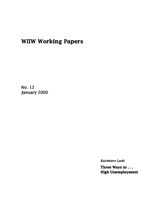Three Ways to ... High Unemployment
The author intends to prove that economic policy in Germany after 1979 was opposed to that recommended by Kalecki in his famous 'Three ways to Full Employment' and was responsible for the surge in unemployment. Part I of the paper sketches the theoretical background of Kalecki's recommendations. Special attention is devoted to private investment, budget deficit and trade balance as factors determining (but not being determined by) private savings. A related topic is the change of the degree of capacity utilization and of labour force.
Part II is devoted to an empirical investigation of Germany in 1960-96. The author comes to the conclusion that two factors were mainly responsible for the slowdown of GDP growth after 1979: first, the weak expansion of private investment, caused - at least to some degree - by the restrictive monetary policy of the Bundesbank and, second, the increase in the private propensity to save, related to an engineered shift in the distribution of income from wages to profits. The increase of the trade surplus in the 1980s and then in the 1990s could not prevent the slowing down of GDP growth and the increase of unemployment provoked by these two factors. In the USA, in contrast, the stagnation of private investment in 1980-91 was counterbalanced by a decrease of the private propensity to save and by an increase of the budget deficit. Thus a stagnation of GDP could be avoided and unemployment did not increase very much.
Keywords: unemployment and its causes, theory of effective demand, private investment, Government budget and trade surplus versus private savings, private savings and GDP, Germany and USA 1960-96
JEL classification: B22, E12, E20, H62
Countries covered: Germany, USA
Research Areas: Macroeconomic Analysis and Policy
